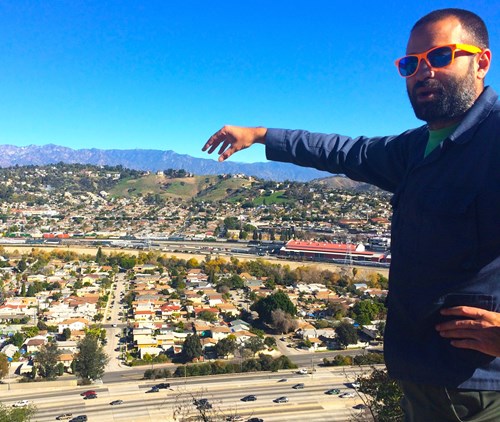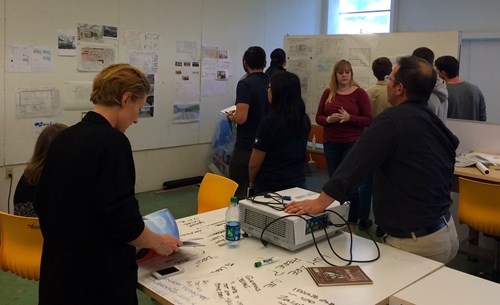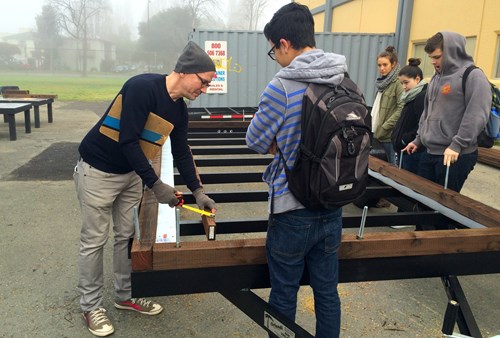US Study Tour: Post #1

arki_lab meets rebel architect in a car-centric city
The first stop of our US study trip was Los Angeles where we met Daveed Kapoor – an architect and urban advocate who fights the car-centrism and urban sprawl through tactile urbanism. Daveed is a founder of utopiad.org – an urban design organisation with a focus on projects that foster connections between people, improve density and walkability and therefore encourage sustainability.
During our encounter we got to learn about several interesting projects in which prototyping and temporary installations are being utilized as the main tools for urban intervention that provides innovative solutions for various urban issues caused by the car-centric features of LA. A great example of this is Spring Street Parklets in which parking spaces in the street are re-purposed by being converted into mini-parks. Or Sunset Triangle Plaza – the first street-to-plaza conversion in LA that we got to visit. In this way we got to know how urban interventions serve as tactics for improving the livelihood of local areas in LA. Moreover, these temporary installations simultaneously pinpoint specific issues and provide ideas for their permanent solution. Furthermore, it was interesting to find out from Daveed that this approach is also a strategy to deal with regid legislations which regulate urban planning in LA on the city-level, instead of addressing them at a local scale.
Therefore, one of our main reflections derived from this inspiring meeting is the importance of micro scale approach in addressing urban issues. In that sense, we strongly believe that working on redevelopments of smaller urban districts (neighborhoods) together with the local community is a better starting point, as opposed to trying to improve the overall city (especially in the case of large urban areas such as LA). The other reflection is the emergence of the new role of architects with which arki_lab strongly identifies with. This new role entails a facilitatory function in which architects/urban designers operate as a medium between the grassroots initiatives and mainstream institutions; between citizens and municipalities; and between our profession and society.
US Study Tour: Post #2

How to design for new ways of learning?
After visiting LA and looking into temporary architecture solutions, we went to Cal Poly to meet with Mark Cabrinha – professor with a PhD in Architectural Science who teaches a very interesting design studio. We got a chance to visit the studio, meet with students and even participate by giving our critique. The students attending the studio have a task of redesigning an existing high school library, which is being under-utilized as a study space. Furthermore, we found Mark’s studio particularly interesting because it takes a different perspective on teaching architecture and education in general.
Firstly, we appreciated this studio because it provides students with a non-typical viewpoint on an architectural project, where the main focus is the experience and meaning of space, instead of dealing primarily with its form. In that sense, we used out critique to encourage students to create design solutions that foster new ways of learning, while transforming the library into a space where the knowledge is shared and therefore generated. In order to help the students develop these new ideas we emphasized flexibility in their design that provides different ways of learning combined with new technologies.
Secondly, we realized that a very strong aspect of this studio is having the reality-based assignment, in terms of producing a design for an exiting space and having it actually implemented. We strongly believe that opportunity to work on real – hands on projects has a particularly strong effect for the learning process. On the other hand, what we notice through our own experience is that current education very much lacks this method. This is the lesson that we especially learned while teaching the scale to primary school students, who often express their satisfaction when realizing how school courses such as math function in their physical environment.
For arki_lab, providing opportunities for students to actually apply new knowledge on every day life situations is the main teaching method, which we will foster event further in the future. By providing new ways of learning we want to simultaneolsy challenge the current educational curriculum and provide it with innovative ways of teaching based on everyday life context.
US Study Tour: Post #3

How to design and build together with the youth?
Visiting Project H and getting an opportunity to meet its founder – Emily Pilloton was definitely one of the highlights of our inspirational tour in US. Project H is a youth-led design studio that teaches middle and high school students design skills based on real, hands-on built projects with a special focus on building for the community. By incorporating the format of a studio into the official curriculum, Project H serves as a platform for a new way of learning, in which the theory and practice are combined.
During our visit, we got a chance to meet the team working in the school as well as students participating in the studio. During our visit they were building tiny houses which will serve as homeless shelters. We were genuinely impressed with the structure of the studio, in which different aspects of a real building site are scaled-down in order for the youth to fully understand and implement it through a very specific timeline. Furthermore, the protocol of the studio ensures that everyone has a role with a specific set of tasks, while providing a safe construction process.
We found out from the students how engaging and fun this process is for them. According to the students, it does not only provide them with craft skills, but it also gives them a sense of pride for doing something that the entire community can benefit from. In this way, Project H represents a successful example of an educational project that creates empowerment for the youth by regarding them as a serious citizen group and giving them a chance to give back to the local community. In addition, the project shows practical ways of engaging the youth in improving their physical and social environments. In that sense, it teaches us a way of bringing together different generations – students and teachers, while working on projects based set in the context of everyday life.
As pointed out by an article in the New York Times, countless academic studies have argued that studying design at school can be hugely beneficial, even for students who have no intention of becoming professional designers, because it builds their confidence by teaching them communication, planning and visualisation skills, that will be useful in any field. This correlates with Emily and arki_lab’s belief that design is a powerful tool that can serve as a social engine for youth empowerment and citizenship in general.
arki_lab strongly recommends viewing the Ted Talk by Emily Pilloton on Teaching Design for Change: http://www.ted.com/talks/emily_pilloton_teaching
US Study Tour: Post #4

experiencing Portland – finding inspiration
Portland was the final point of our study tour in United States. This city is indeed a great inspiration for us, especially in terms of its history of planning and successful examples of urban resilience, mixed-use redevelopments and urban design solutions. Besides conducting our field study in the city, we also did a few academic visits to the University of Oregon. Firstly, we were invited to do a guest critique at an architecture studio, in which we gave our feedback and provided the students with fresh perspectives on their thesis work.
Furthermore, we visited the Department of Architecture at University of Eugene. There we met with professor Peter Keyes who gave us a tour of the campus and the studios. This was also an opportunity for Rasmus to meet with the students who previously took his courses at DIS, during their study abroad period in Copenhagen. The structure of these courses enables the students to travel frequently during their studies, in order to become exposed to a variety of built projects and new physical environments. In that sense, DIS design studios are definitely an important source of inspiration for the students who get to live in Copenhagen and utilize Europe as their classroom. In Portland, we discussed how strongly they are influenced as future designers by the experience of studying in Copenhagen and traveling through Europe. Moreover, Rasmus was happy to see them again while working in their home environment, where they get to apply the knowledge gained in Copenhagen.
Blog author: Ognjen Sobat
Share this Post

